Having plants in an aquarium is not a new thing, but in recent years, having a fully planted tank has become more desirable for most aquarists. Live plants will bring joy and beauty to any tank and will make fish feel more at home. We see more interest in planted tanks than just a fishtank. In a planted tank, fish are not the focal point and they are there just to compliment plants.
Regardless of the type of tank you want to make, we believe it is always best to have live plants to add more beauty and functionality to your tank. Live aquarium plants will look much more natural and beautiful than artificial plants. Keeping live plants in an aquarium is super easy if you follow proper plant keeping guidelines.
Most aquarium plants are very hardy and can tolerate a wide range of water parameters. These plants are specially selected for the aquarium hobby for their hardiness and beauty.
In this article, we will look at the most popular types of freshwater plants that you can keep in your tanks.
- Benefits Of Live Plants In An Aquarium
- Most Popular Types Freshwater Aquarium Plants
- 20. Moneywort (Bacopa monnieri)
- 19. Rotala Indica
- 18. Buce Plants (bucephalandra)
- 17. Bacopa Caroliniana
- 16. Water Sprite (Ceratopteris thalictroides)
- 15. Rotala Rotundifolia
- 14. Hornwort (Ceratophyllum species)
- 13. Anubias
- 12. Guppy Grass (Najas guadalupensis)
- 11. Anacharis
- 10. Java Fern
- 9. Java Moss
- 8. Amazon Frogbit
- 7. Duckweed
- 6. Dwarf Water Lettuce (Pistia stratiotes)
- 5. Jungle Val (Vallisneria)
- 4. Dwarf Hairgrass
- 3. Subwassertang (Lomariopsis lineata)
- 2. Marimo Moss Ball
- 1. Amazon Sword (Echinodorus grisebachii)
- Choosing The Right Plants For Your Aquarium
- Conclusion
Benefits Of Live Plants In An Aquarium
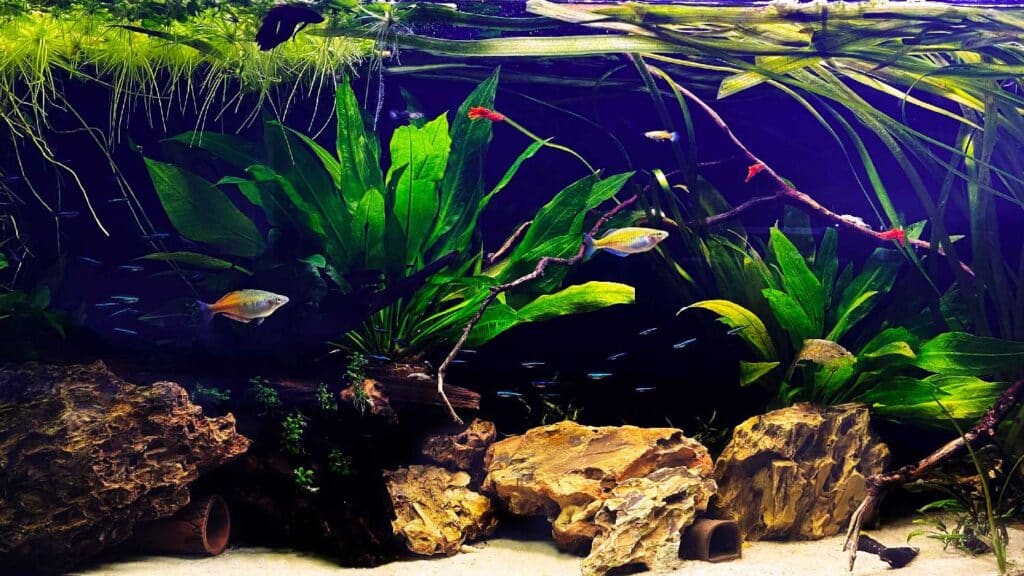
Live plants will add a lot of benefits to your tank and can make life much easier and healthier for your fish. Unlike artificial plastic plants, the live plants will bring more than just aesthetics. The following are the top reasons why you should have plants in your tank.
- Live plants will enhance water quality by removing fish waste and toxins from the water. This can cause less water changes on your side.
- They prevent algae growth by consuming nutrients (AKA fish waste) and not leaving anything for the algae to feed on. Algae is probably the biggest problem of tanks with no plants.
- During the day or when lights are on, plants will produce oxygen and oxygenate the water. This will help you fish to not suffocate.
- Live plants will use CO₂ produced by fish. High amounts of carbon dioxide will have a negative impact on fish as well as water parameters of your tank.
- Freshwater plants will make your fish feel more safe and sound. Fish can easily get spooked by movements outside the tank. Having plants will make them feel safe and as a result develop deeper coloration.
- Most fish will need live plants to spawn. Egg scatter fish are often laying their eggs on plant leaves so having plants will encourage them to spawn and breed.
- Plants will also give your newly-hatched fry a safe place to hide and grow. Most fish will hunt and eat fry and other small species. Plants will help them hide until they reach a larger size.
Most Popular Types Freshwater Aquarium Plants
There are many freshwater plants in the aquarium hobby. Some are super hard to keep and some are super easy. We, however, have gathered the most popular type of plants to help you pick the right plants for your tank.
20. Moneywort (Bacopa monnieri)
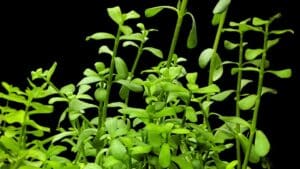
Moneywort (Bacopa monnieri) is a well-known species of freshwater aquarium plant. It is a robust stem plant that has deep green leaves and can get to a reasonable size.
Moneywort is a perennial creeping plant that is found in the swamps and wetlands of southern and eastern India, Africa, Australia, and the North and South American continents.
In the US, Texas, Florida, and Hawaii are where this plant can be funded in large numbers.
Moneywort is also referred to as Bacopa monnieri, water hyssop, brahmi, thyme-leafed gratiola, waterhyssop, herb of grace, and Indian pennywort.
In many cases, people confuse Moneywort (Bacopa monnieri) for Creeping Jenny (Lysimachia nummularia). These plants are two distinct species but some use the name “Moneywort” for both plants. This is why it becomes confusing.
Moneywort is a flowering plant that can thrive in both submerged and emersed conditions. Under the right lighting, its succulent can look lime green, giving your tank a unique look.
This plant is suitable for aquarists of all expertise levels and can make a great addition to any community tank. For more information please read our full guide on Moneywort plant care requirements.
19. Rotala Indica
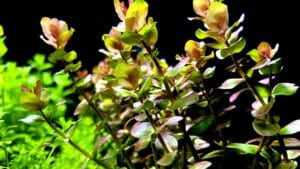
Rotala Indica is a magnificent stem plant that has recently gained a lot of recognition in the aquarium hobby. These plants are noted for their adaptability and can survive in a variety of environments and water conditions.
The Lythraceae (loosestrife) family of plants, which includes Rotala Indica, is endemic to Southeast Asia. These plants grow tall and densely which makes them look appealing to aquarium owners. Many aquarists use this lovely background plant for its unique leaf colors and its ability to grow tall.
In the wild, it is common to see this plant in rice fields, where it goes by the name Indian Toothcup. They are commonly viewed as a weed by rice producers due to their rapid growth. Similar to rice plants, the Rotala Indica can grow submerged and emersed.
This plant grows tall but will also creep sidewise, creating dense jungle-like views. When combined with other plants, this plant can create stunning and vibrant landscapes in a tank.
Rotala Indica is a type of flowering plant characterized by beautiful leaf colors that can become red under special conditions. This plant may look weak and fragile, but it is actually quite resilient and adaptable. As a result, they are a great plant for new aquarists as well.
For more information please read our full guide on Rotala Indica.
18. Buce Plants (bucephalandra)
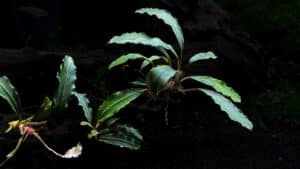
The Buce Plants, or Bucephalandra, is a genus of aquatic plants usually referred to as Buce Plants among aquarists. These small and tough plants are slow-growing species and can produce a tiny beautiful flower.
Species of the Bucephalandra genus share a similar mold but can develop distinctly shaped leaves. That said, when it comes to their care requirements, they all share the same care requirements when kept in an aquarium.
Buce plants are native to Borneo island which lies in Southeast Asia. They are often found on the sides of rivers where water tides can occur.
The Bucephalandra genus has hundreds of varieties; however, only a select few species are often found in pet stores. More rare types of Buce plants are often sold more expensive and only will become available only once in a while.
These plants are quite new to the aquarium hobby but they’ve gained a lot of attention quickly. The growing demand has prompted nurseries to start commercially producing these plants and rare types of these plants are becoming available.
For more information please read our full guide on Buce Plants.
17. Bacopa Caroliniana

Bacopa Caroliniana is a stunning plant that is used in the aquarium hobby. This plant has been a staple part of many aquascapes for quite some time. They are hardy and beautiful green plants that are sought after by aquarists of all skill levels.
Native to North America, this beautiful plant develops lush green coloring on its leaves that will bring any tank to life. They can live in an emersed or submerged environment. They will also produce beautiful flowers that can grab anyone’s attention.
This plant can thrive in any water and substrate conditions. They tolerate a broad range of water parameters making them great aquarium plants for beginners.
Depending on where you live, you could hear this plant referred to as Bacopa amplexicaulis, Herpestes caroliniana, Obolaria caroliniana, Herpestes amplexicaulis, or Lemon Bacopa.
Bacopa Caroliniana is commonly used to make Paludariums as it can grow emersed as well. The nurseries, where they commercially grow this plant, are also growing this plant emersed as it grows faster above water.
For more information please read our full guide on Bacopa Caroliniana.
16. Water Sprite (Ceratopteris thalictroides)
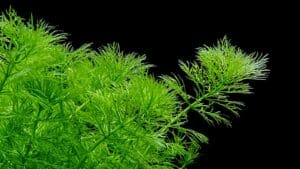
Water Sprite (Ceratopteris thalictroides) is a fern species of aquatic plant that is used in aquariums for a long time. This plant is very hardy and can tolerate aquarium conditions without showing any issues. This makes them even more popular in the aquarium hobby.
At the same time, they’re quite affordable for a plant. Most pet stores offer this plant at an affordable price which makes them even more popular. Their distinct leaf structures and lush green colors make them an easy sell in any pet shop.
The Water Sprite is a dense plant that can thrive both in and out of water. But the leaves will look extremely different when grown in water vs when grown on land. the emersed leaves are often larger, thick, and spongy.
A large number of these plants can be found in Southeast Asia, Northern Australia, Africa, India, the Philippines, and some regions of America. But they can be found in all the tropical regions of the world.
Their ability to grow both planted or floated in the water makes them a great option for any tank. However, they grow much better when they are planted in a nutrient-rich substrate.
For more information please read our full guide on Water Sprite Plant.
15. Rotala Rotundifolia
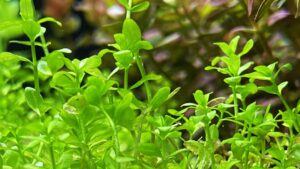
A fast-growing stem plant, Rotala Rotundifolia comes in a few different varieties. There are several variants of this plant that can develop slightly different leaf shapes and coloration. The most well-known varieties are Rotala Colorata, Rotala H’ra, and Rotala Ceylon.
Rotala Rotundifolia can develop rich green or dark red leaf colorations. The coloration of the leaves depends on the type you have and also on the conditions you are keeping them at. This plant is super easy to grow as it can adapt to different water conditions.
Originally from southeast Asia, Japan, and southern India, this plant is currently commercially cultivated in many different parts of the world. It flourishes in high-tech aquariums but will also grow in low-tech tanks.
Rotala Rotundifolia can grow partially out of the water as well as entirely emersed. Due to this quality, they are ideal for both aquarium and Paludarium setups. However, there will be subtle differences between plants that grow above water or below water.
Rotala rotundifolia is a great plant to have if you want to make your tank more colorful. You can create a densely grown jungle look and feel in your tank using this plant. This plant will flourish if you provide them with proper lighting conditions and care.
For more information please read our full guide on Rotala Rotundifolia.
14. Hornwort (Ceratophyllum species)

Hornwort (Ceratophyllum demersum) is a popular aquarium plant that is sold at just about any pet store. It’s common to see this plant referred to as “hornwort,” “coontail,” or “coon’s tail” in pet stores.
This beautiful aquarium plant is free-floating species, so no special substrate is needed to grow them. They need almost no attention or care as long as they get enough light. Because of its hardy nature, this plant is great for inexperienced fish keepers.
Hornwort is a fast-growing herb that grows naturally in almost any part of the world. Depending on the location they grow, they have evolved into a few different variants. All these variants share a similar look and need the same care requirements.
Hornwort thrives in tanks that have still or moderately moving flow. in the wild they live in a similar environment as well. This plant cannot survive in rivers and streams with a strong current as it has fragile stems.
This aquatic plant grows rapidly and will easily create a dense bush in your tank. Because of this, they are ideal for breeding tanks and tanks that have small fish. Many breeders use them in their tanks to remove excess ammonia and provide protection for fry.
For more information please read our full guide on Hornwort.
13. Anubias
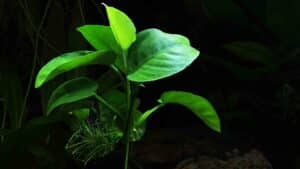
By far the Anubias plants are one of the most common types of aquarium plants in the hobby. These aquatic plants require virtually no special care and can live in any tank conditions. The name “Anubias” really describes a group of related plant species rather than just one plant. Each species of anubias can grow to different sizes but they all share the same care requirements.
This plant grows natively throughout the tropical parts of western Africa. This part of Africa has a tropical climate with high temperatures and high humidity. The plants in the Anubias genus can grow above water in humid areas or fully submerged under water.
These aquatic plants can range from a few centimeters to a few feet in size. Regardless of their size they all develop similar leaf shapes and grow in a similar pattern. They also prefer to grow in the shade and will cling to rocks, driftwood, and other objects.
For more information please read our full guide on Anubias.
12. Guppy Grass (Najas guadalupensis)
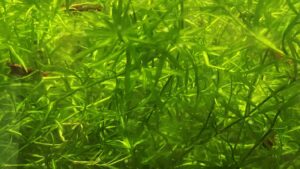
Guppy Grass, or Najas Grass, is a fast-growing aquatic plant that is prized by aquarists for its dense growth. This plant is commonly used by fish keepers in the breeding tank or shrimp tanks.
Najas grass is famous as Guppy Grass because it has been a staple part of many guppy breeding facilities around the world. However, they are also known by other names such as Common water nymph, southern water nymph, water nymph, and Najas grass are a few more.
This plant is very low maintenance and grows rapidly when exposed to adequate light and fertilizer. They do not need any special care other than pruning from time to time.
Guppy Grass is found naturally in Canada (from Alberta to Quebec). However, it also grows in other parts of America, including South and Central America, Mexico, the West Indies, and the United States. Because of its widespread usage in the aquarium trade, this plant is now found in Japan, Israel, and a few other countries.
Guppy grass’s dense and bushy growth makes it suitable for guppies or shrimp breeding tanks. It can provide the ideal hiding place for fry, keeping larger adult fish at bay. Most adult fish will avoid swimming in areas with dense vegetation due to the risk of becoming entangled.
For more information please read our full guide on Guppy Grass.
11. Anacharis
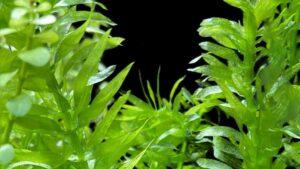
Anacharis plants are famous types of aquarium plants that have become very famous nowadays. The fact that they are incredibly easy to care for and have beautiful leaves are the main reason for their popularity. If you’re looking for a lush green plant for your low-tech community tank, this one could be a good choice.
Anacharis plants are native to South America, where they thrive in tropical freshwaters. Anacharis plants are found in a few different varieties in the wild. There are two variants of this plant that are mainly available in pet stores, Egeria Densa (Brazilian waterweed) and the Elodea genus.
The Brazilian waterweed, scientifically known as Egeria Densa, is the more readily available of the two plants known as Anacharis in the fishkeeping hobby. The Brazilian waterweed variant is popular since it produces longer leaves. Both types of Anacharis plants have similar care requirements and needs.
Anacharis is a simple plant that grows beautiful semi-transparent green leaves. They can thrive in most aquarium conditions as long as your aquarium conditions meet the minimum requirements of this plant. Fortunately, they can handle a wide range of parameters and this makes them a great beginner-friendly plant.
For more information please read our full guide on Anacharis.
10. Java Fern
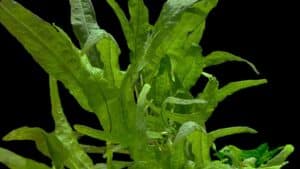
The Java Fern (Ceratophyllum demersum) is popular among fish keepers because of its slow growth rate in an aquarium environment. This is an excellent plant for beginners since it requires minimal care.
That said, many well-known aquarists also use this plant in their aquascapes. This plant will grow lush green leaves on a tough rhizome. Which makes aquascaping with it super easy. This made many fish keepers to start keeping this plant.
The Java Fern is mainly found in a few South Asian countries. The vast majority of this plant comes from the Indonesian island of Java. This is why it became famous as the “Java” Fern.
In addition to Java Island, this plant may be found in northeastern India, Thailand, and even certain parts of China. Where it grows in highly humid areas above water. This plant usually establishes itself on rocks and other rough surfaces.
They can be found clinging to wood and even planted in the substrate. But they are mainly seen clinging to rocks either underwater or above water.
For more information please read our full guide on Java Fern.
9. Java Moss
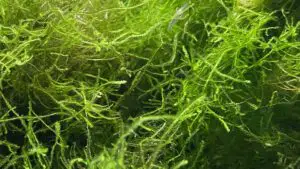
Java moss is without a doubt one of the most common plants used in the aquarium hobby. These semi-aquatic moss plants are hardy and can grow in almost any tank conditions. Because of their adaptive nature, it is quite easy to work with them to create wonderful aquascapes.
You can use this moss to create carpets, a green living background, or as leaves for driftwood. This moss is one of the most versatile types of plants you can own. They are super easy to grow and can make any tank ten times more beautiful.
Java mosses available in the hobby are scientifically divided into two types: Taxiphyllum barbieri and Vesicularia dubyana. Both are quite similar and differentiating them can be difficult.
The two java moss variants originated in South Asia. This plant can be found growing natively in Singapore, Malaysia, Indonesia, Japan, the Philippines, Vietnam, and other surrounding islands. Large colonies of Java moss may be found on Indonesia’s Java Island. That is why it is known as “Java” moss.
Java moss can grow in or out of water. In their natural habitat, they live near sources of water where humidity is high. The water will rise in the rainy season and will evaporate in the summer season giving this moss an ideal living space.
For more information please read our full guide on Java moss.
8. Amazon Frogbit

Limnobium laevigatum, popularly known as Amazon Frogbit, is an attractive floating aquarium plant that has grown in popularity in recent years. It’s safe to assume that this plant outperforms all other Surface floating plants in terms of aesthetics. Its long silky roots and green leaves will transform your aquarium into a tiny Amazon river.
The Amazon Frogbit is exclusively found in tropical and subtropical areas in Central and South America. They are also known as West Indian spongeplant, South American spongeplant, smooth frogbit, and sponge plant.
This plant is great for keeping your aquarium clean. The roots will consume excess nutrients directly from the water column making the water clean and healthy for the fish. Because it covers the surface of the tank it can reduce the risk of algae outbreaks.
At the same time, it grows slower than other surface-floating plants like duckweed or water lettuce. This makes them more controllable and easy to manage. The leaves are also large and smooth which makes this plant more beautiful. As a result, they are regarded as one of the most beautiful plants in the aquarium hobby.
For more information please read our full guide on Amazon Frogbit.
7. Duckweed
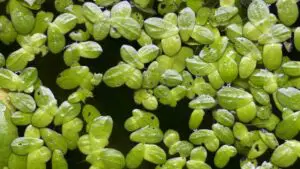
Duckweed (Lemna Sp.) is a tiny species of floating aquarium plant. They are probably the tiniest aquarium plants you can own. This plant grows on still surfaces and moving waters can kill it. So when the surface of your tank is still you can expect to get a green carpet coving your tank’s surface.
Originally from North America, Central America, Asia, Africa, and Europe, duckweed is now found worldwide. They have now been introduced to Australia and South America as invasive plants.
They thrive in any body of water as long as it is still and not moving. They are usually seen floating on the surface of ponds and bogs. It can withstand cold temperatures in USDA plant hardiness zones 4 through 10. Making them one of the hardiest tiny plants on earth.
Because of their rapid growth and propagation rate, they make a great plant to remove fish waste from the tank. This plant is loved by many aquarists as it helps them to remove fish waste and is hated by others because of how quickly it multiplies and how difficult it is to eradicate.
The term “Duckweed” comes from the fact that ducks enjoy eating it. However, it is also a favorite meal of many other fish and animals. Duckweed is a popular food source for a wide variety of animals, including koi, goldfish, tilapia, carp, chickens, turkeys, turtles, and many more.
Due to its high protein content, duckweed is increasingly being cultivated on a commercial scale as a food source for pets. They grow rapidly and have high nutrients, making them a great plant to commercially produce for pet foods.
For more information please read our full guide on Duckweed.
6. Dwarf Water Lettuce (Pistia stratiotes)
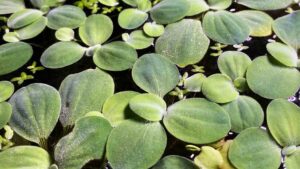
Dwarf Water Lettuce, scientifically known as Pistia stratiotes, is a hardy floating type of aquarium plant. Water lettuce is also known as Nile cabbage, water cabbage, and shellflower.
The water lettuce comes in two different sizes. The smaller “Dwarf” Water Lettuce type is more typically seen in aquariums and the giant water lettuce is often used in ponds.
Water lettuce was first discovered in Africa’s Nile River near Lake Victoria. However, they are currently found in most tropical and subtropical regions across the world. They were also introduced to South America, where they have now spread across the Amazon basin.
Water lettuce is considered an invasive species by many countries due to its quick growth rate and its ability to easily invade rivers. Water lettuce flourishes on the surface of calm ponds and slow-moving rivers. But can not grow in fast-moving waters.
When you keep this plant you will need to make sure it can not make its way out of your tank. If you are living in warmer areas having this plant can be a risk to your local waterways. They will grow and spread swiftly in water that is rich in nutrients.
Many aquarium keepers enjoy them because of the massive root systems they form in the tank. Because of its fast growth rate and well-established roots, water lettuce is an excellent plant for eliminating waste from a tank.
For more information please read our full guide on Dwarf Water Lettuce.
5. Jungle Val (Vallisneria)
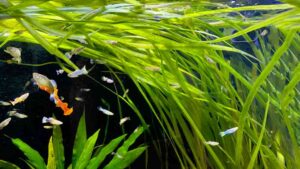
Jungle Val is an excellent aquarium plant that will deliver stunning vistas into your tank. This plant is easy to care for that will create a lush aquatic jungle in your tank. The leaves will grow tall and long and often outgrow a tank if not pruned regularly.
Jungle Vallisneria, commonly known as Jungle Val, is also known as Tape Grass, Eelgrass, wild celery, and Water Celery. There are a few different types of Vallisneria plants. But the most common type of Vallisneria in the aquarium hobby is Vallisneria Americana.
Vallisneria plants are endemic to the United States, and South America. They grow in lakes, rivers, and streams all over the mentioned countries. They often grow in areas where water is shallow and no deeper than 10 feet.
If you have the right tank setup, you can easily keep and cultivate a Jungle Val in your aquarium. At first, it might not do well in your tank but after it becomes established, it reproduces rapidly and grows super fast.
For more information please read our full guide on Jungle Vallisneria.
4. Dwarf Hairgrass
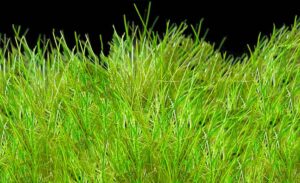
Dwarf Hairgrass (Eleocharis parvula) is a great plant to create a green carpet in your aquarium. There are many other carpeting plants and some of them can create better carpets but dwarf hair grass is definitely the sturdiest one. Most other carpeting plants are too sensitive and require a special high-tech setup to be able to survive.
Dwarf Hairgrass is the best option if you want to grow a lush lawn in your aquarium but you do not want to spend a lot on gadgets. This plant can make a beautiful carpet while oxygenating the water, filtering out harmful chemicals, and providing protection for young fish.
Eleocharis parvula is the scientific name for the Dwarf Hairgrass, which is a member of the Cyperaceae family of plants. It is a common aquatic plant that thrives in shallow, well-lit, brackish, or freshwater environments worldwide. The dwarf hairgrass is a semi-aquatic plant and can grow both in and out of water.
As mentioned, this plant is commonly used as a carpeting plant by aquarists. Due to its rapid growth rate, this plant is a great option for quickly establishing an aquarium carpet. However, they are also great plants for nano tanks.
For more information please read our full guide on Dwarf Hairgrass.
3. Subwassertang (Lomariopsis lineata)

The subwassertang, or Loriaiopsis lineata, is the ideal low-light aquarium plant for shrimp tanks and nano aquariums. The Süsswassertang, often spelled Subwassertang, is a kind of freshwater fern found in Southeast Asia. It is also known as the Loma fern and the round pellia.
Tang means “seaweed” in German, while süßwasser means “freshwater.” The ß in German indicates “s,” hence the true pronunciation of “Süßwassertang” is “Süsswassertang,” but because it looks like the English letter b, it became known as “Subwassertang.”
Because of its low light needs and ease of care, subwassertang is among the best plants for shrimp tanks. The growth rate of this plant is moderate, yet it is quite hardy. Subwassertang won’t spread like mosses and take over your entire aquarium. This plant is ideal in a slow-moving shrimp tank.
For more information please read our full guide on subwassertang.
2. Marimo Moss Ball
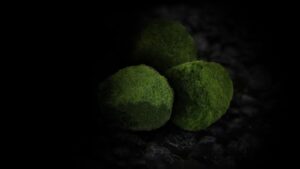
When it comes to shrimp and betta tank greenery, Moss Balls are the way to go. Marimo Moss Ball is not a moss! It’s rather a rare growth form of Aegagropila linnaei green algae which naturally occurs in lakes and rivers across Japan, Northern Europe, and Australia.
This algae plant is an ideal “plant” for fish keepers of all skill levels. They are super hardy and can withstand most tank conditions. They will not spread like other algae normally do. They will remove toxins from your tank making it much healthier for your fish.
Marimo means “Seaweed ball” in Japanese. These ball-shaped algae occur naturally in bodies of water with a strong current. The water makes the algae roll and form a ball shape.
In order to refer to it more simply, aquarium keepers began using the word “Moss Ball,” which eventually became widely used in North America.
For more information please read our full guide on Marimo Moss Ball.
1. Amazon Sword (Echinodorus grisebachii)
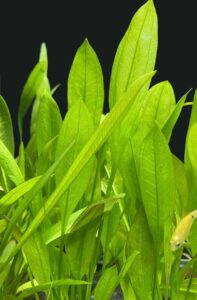
The Amazon sword (Echinodorus grisebachii) is a famous aquarium plant that is almost always available in pet stores. It thrives with minimal attention and is an exceptionally tough plant that is able to endure a diverse variety of tank conditions.
This large aquarium plant is native to Cuba, Central America, and southern South America (Brazil and Bolivia). The leaves of this plant can look slightly different depending on the type of amazon sword you get.
Each variant of the Amazon Sword is named for its distinctive leaf form, which all resembles a sword. These variants might look slightly different but they all share the same care and maintenance requirements.
The leaves of this plant have a central vein that extends from the root and is long and ribbed. The unusual form of the leaves is similar to a sword blade. Which is why they are called Amazon Sword plants.
This plant is both beautiful and easy to maintain; making it a beginner friendly plant. It’s an excellent plant as a background plant for your aquarium since it can grow tall and large.
For more information please read our full guide on Sword Plant.
Choosing The Right Plants For Your Aquarium
The ideal way to pick and select plants for an aquarium is by selecting them based on the water parameters and lighting conditions your tank has. The good news is that all the plants we mentioned can live in most tank conditions as long as you have a good light.
Most of the plants we mentioned can live in a tropical environment in neutral ph levels. The only factors you will need to consider are water movement and if the plants need substrate or not. The good news is that we covered all the aspects of each plant’s care. If you want to learn more you can follow the link for each plant to learn more about them and to see if they are compatible with your tank or not.
There are many plants available in the aquarium hobby, some are easy, some are hard to keep. We tried to gather the easiest and most famous of all and narrow your search down. These plants are hardy and can go with most fish. But make sure your plant and the type of fish you have can live together. Some fish are known to destroy plants.
Conclusion
Keeping a clean aquarium is good for the health of your fish and is more appealing to the eyes of viewers. Live aquarium plants are a great way to improve the aesthetic of your tank and to keep your aquarium clean and balanced. We highly recommend having live plants to remove toxins from the water and give your tank a more natural look.